
Kunzea ericoides, commonly known as kānuka, kanuka, white tea-tree or burgan, is a tree or shrub in the myrtle family, Myrtaceae and is endemic to New Zealand. It has white or pink flowers similar to those of Leptospermum and from its first formal description in 1832 until 1983 was known as Leptospermum ericoides. The flowers have five petals and up to 25 stamens which are mostly longer than the petals.

Kunzea salina is a species of flowering plant in the myrtle family, Myrtaceae and is endemic to the south of Western Australia. It is a low, spreading, densely branched shrub with leaves mostly arranged in opposite pairs and usually two sessile pale pink to white flowers arranged at the base of new shoots. It only grows near the edge of certain salt lakes.
Kunzea glabrescens, commonly known as spearwood, is a flowering plant in the myrtle family, Myrtaceae and is endemic to the south-west of Western Australia. It is a large shrub with leaves and flowers similar to those of K. ericifolia but has differently shaped bracteoles. It is often common in wet areas around Perth.

Kunzea pulchella, commonly known as granite kunzea, is a flowering plant in the myrtle family, Myrtaceae and is endemic to the south-west of Western Australia. It is a shrub with spreading branches, egg-shaped to lance-shaped leaves and loose groups of red flowers, each on a short stalk so that the branch is visible between the flowers.

Kunzea baxteri, commonly known as scarlet kunzea, is a flowering plant in the myrtle family Myrtaceae, and is endemic to the south-west of Western Australia where it occurs near granite outcrops and hills. It is a shrub with large, scarlet, bottlebrush-like flower clusters, making it popular as a garden feature.
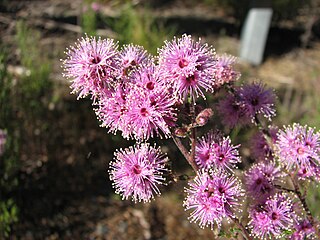
Kunzea parvifolia, commonly known as the violet kunzea, is a flowering plant in the myrtle family, Myrtaceae and is endemic to eastern Australia. It is a wiry shrub with small, narrow leaves and clusters of pink to purple flowers in spring.
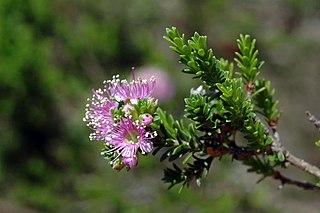
Kunzea ciliata is a flowering plant in the myrtle family, Myrtaceae and is endemic to the south-west of Western Australia. It is a spreading shrub which typically grows to a height of 0.8 to 1.5 metres and blooms between October and November producing pink flowers.

Kunzea clavata, commonly known as the Torbay spearwood, is a flowering plant in the myrtle family, Myrtaceae and is endemic to a small area on the south coast of Western Australia. It is a shrub or tree, typically with many branches and grows to a height of 2.5 to 4 metres. It blooms between September and October producing yellow flowers.
Kunzea eriocalyx is a flowering plant in the myrtle family, Myrtaceae and is endemic to a small area on the south coast of Western Australia. It is a shrub with spreading main stems with a few short side branches and which grows to a height of 0.5 to 1 metre. It blooms between August and October producing pink flowers.

Kunzea newbeyi is a flowering plant in the myrtle family, Myrtaceae and is endemic to a small area along the south coast of Western Australia. It is a robust shrub with small leaves and groups of about twenty to thirty pink flowers in October and November.
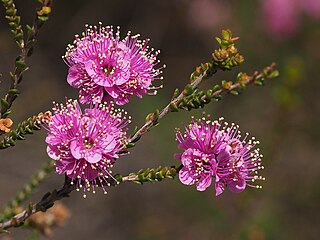
Kunzea rostrata is a species of flowering plant in the myrtle family, Myrtaceae and is endemic to an area along the south west coast of Western Australia. It is a shrub with small, mostly elliptic leaves and with groups of between mostly eleven and fifteen rose pink flowers mainly on the ends of branches that continue to grow after flowering.
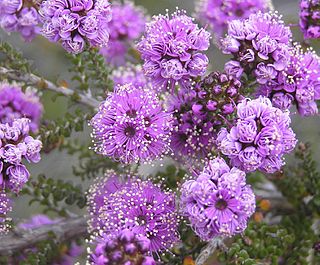
Kunzea recurva is a flowering plant in the myrtle family, Myrtaceae and is endemic to Western Australia. It is an uncommon shrub with small leaves and groups of pink or purplish flowers on the ends of the branches.
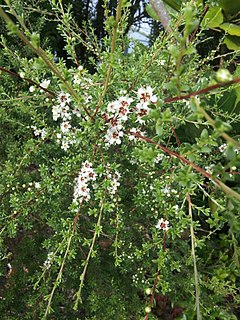
Kunzea amathicola, also known by the Maori names manuka and rawiritoa, is a flowering plant in the myrtle family, Myrtaceae and is endemic to New Zealand. It is a densely-branched, densely-foliaged large shrub or tree with sprays of large white flowers with a red centre.
Kunzea aristulata is a flowering plant in the myrtle family, Myrtaceae and is endemic to a small area of New South Wales. It is an erect, spreading shrub similar to Kunzea rupestris but is distinguished from it mainly by the shape of its leaves. It is only known from a remote area north of Yerranderie where it often grows on cliff edges.

Kunzea obovata is a flowering plant in the myrtle family, Myrtaceae and is endemic to eastern Australia. It is a spreading shrub with unusually-shaped leaves and clusters of pink to purple flowers. It is restricted to northern New South Wales and south-eastern Queensland.
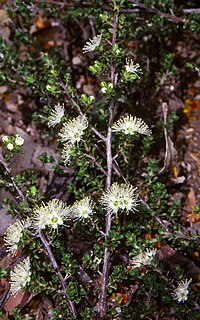
Kunzea badjaensis is a flowering plant in the myrtle family, Myrtaceae and is endemic to a small area of New South Wales. It is a shrub with egg-shaped leaves and clusters of white flowers near the end of the branches. It grows at high altitudes on the Southern Tablelands.

Kunzea flavescens is a plant in the myrtle family, Myrtaceae and is endemic to Queensland. It is a spreading shrub which has egg-shaped leaves and groups of white or cream-coloured flowers on the ends of the branches in September and October.

Kunzea linearis, also known by the Maori name rawiri manuka, is a flowering plant in the myrtle family, Myrtaceae and is endemic to New Zealand. It is a densely-foliaged shrub or small tree, characterised by very narrow leaves and clusters of small white flowers with five petals and a large number of stamens, which are longer than the petals. It grows in the north of the North Island and is the most distinctive of the New Zealand kunzeas.
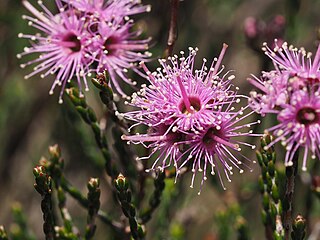
Kunzea opposita is a plant in the myrtle family, Myrtaceae and is endemic to eastern Australia. It is a spindly shrub which has small leaves arranged in opposite pairs, and pink flowers with five petals and many stamens, the stamens much longer than the petals. It usually grows in woodland or on exposed cliffs.
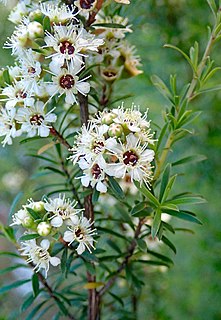
Kunzea robusta, commonly known as rawirinui or kanuka, is a tree in the myrtle family, Myrtaceae, and is endemic to New Zealand. It has rough, stringy, or corky bark, lance-shaped leaves that are darker on the upper surface, flowers in compact groups of up to 30, each with five or six white petals, and about 35 stamens of varying lengths.

















